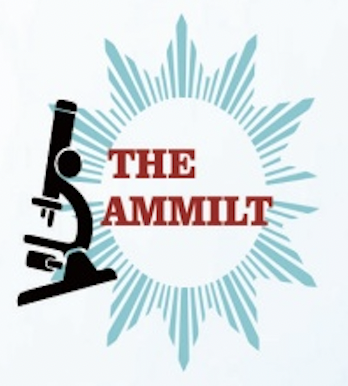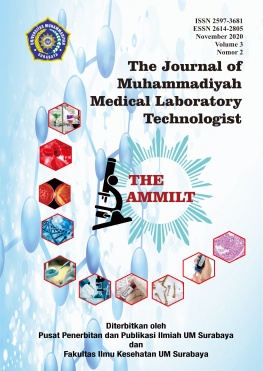Isi Artikel Utama
Abstrak
Breast milk has advantages compared to other milk, including the temperature of breast milk being the same as body temperature, cleanliness being guaranteed, and the content of breast milk plays an essential role in the growth of brain cells and the development of the nervous system. This study aims to describe the content of protein levels in breast milk. The samples used in this study were five samples of breast milk obtained from mothers who had children aged 0-6 months in the Surabaya area, using the Kjeldahl method. The average protein content of breast milk (is 12.764%). The protein content of breast milk has a higher protein content in laboratory tests because it adapts to the needs of the baby. Breast milk has a high protein content. The protein in breast milk is mostly whey protein rather than casein. The higher casein content will form relatively hard lumps in the baby's stomach, making it difficult to digest. The whey in formula milk contains lactoglobulin, which can cause allergies in babies. Mothers are expected to follow WHO recommendations to provide exclusive breastfeeding for 0-6 months and continue breastfeeding until the child is two years old.
Keywords : Protein, content, breast milk, babies
Rincian Artikel
Referensi
- Andreas, N., & Kampmann, B. (2015). Human breast milk: A review on its composition and bioactivity. Elsevier, 91(11), 629–635. https://www.sciencedirect.com/scien ce/article/pii/S0378378215001772
- Audihani, A. L., Astuti, A. P., & Maharani, E. T. W. (2020). Perbedaan kandungan protein dan laktosa pada ASI dan susu formula (usia 0-6 bulan). EDUSAINTEK, 4.
- Balogun, O. O., O’sullivan, E. J., Mcfadden, A., Ota, E., Gavine, A., Garner, C. D., Renfrew, M. J., & Macgillivray, S. (2016). Interventions for promoting the initiation of breastfeeding. Cochrane Database of Systematic Reviews, 2016(11). https://doi.org/10.1002/14651858.CD 001688.PUB3/ABSTRACT
- Boquien, C.-Y . (2018). Human milk: an ideal food for nutrition of preterm newborn. Frontiers in Pediatrics, 6, 295.
- della Guardia, L., Roggi, C., & Cena, H. (2016). Diet-induced acidosis and alkali supplementation. International Journal of Food Sciences and Nutrition, 67(7), 754–761.
- Dupont, C. (2017). Gastroesophageal reflux (GER) in the preterm baby. Gastroesophageal Reflux in Children: GER in Children, 111–
- https://doi.org/10.1007/978-3-
- -60678-1_8
- Fadlliyyah, U. R. (2019). Determinan
- faktor yang berpengaruh pada pemberian ASI eksklusif di Indonesia. Jurnal Ilmu Kesehatan Masyarakat, 15(1), 37–42.
- Grote, V., Verduci, E., Scaglioni, S., Vecchi, F., Contarini, G., Giovannini, M., Koletzko, B., & Agostoni, C. (2016). Breast milk composition and infant nutrient intakes during the first 12 months of life. European Journal of Clinical Nutrition, 70(2), 250–256.
- Hester, S. N., Hustead, D. S., Mackey, A. D., Singhal, A., & Marriage, B. J. (2012a). Is the macronutrient intake of formula-fed infants greater than breast-fed infants in early infancy? Journal of Nutrition and Metabolism, 2012.
- Hester, S. N., Hustead, D. S., Mackey, A. D., Singhal, A., & Marriage, B. J. (2012b). Is the macronutrient intake of formula-fed infants greater than breast-fed infants in early infancy? Journal of Nutrition and Metabolism, 2012.
- Koletzko, B., von Kries, R., Closa, R., Escribano, J., Scaglioni, S., Giovannini, M., Beyer, J., Demmelmair, H., Gruszfeld, D., Dobrzanska, A., Sengier, A., Langhendries, J. P., Cachera, M. F. R., & Grote, V . (2009). Lower protein in infant formula is associated with lower weight up to age 2 y: a randomized clinical trial. The American Journal of Clinical Nutrition, 89(6), 1836–1845. https://doi.org/10.3945/AJCN.2008.2 7091
- Liansyah, T. M. (2015). Malnutrisi pada anak balita. Jurnal Buah Hati, 2(1), 1–12.
- Åubiech, K., & Twarużek, M. (2020). Lactobacillus bacteria in breast milk. Nutrients, 12(12), 3783.
- Martin, C. R., Ling, P.-R., & Blackburn, G. L. (2016). Review of infant feeding: key features of breast milk and infant formula. Nutrients, 8(5), 279.
- McCleary, B. v. (2010). Development of an integrated total dietary fiber method consistent with the Codex Alimentarius definition. Cereal Foods World, 55(1), 24–28.
- Oktavia, Y . (2015). Perbandingan antara Kandungan Protein Air Susu Ibu (Asi) dengan Susu Formula untuk Bayi Usia 0-12 Bulan yang Beredar di Pontianak. Jurnal Mahasiswa PSPD FK Universitas Tanjungpura, 3(1).
- World Health Organization. (2018).
- Nurturing care for early childhood development: a framework for helping children survive and thrive to transform health and human potential.
- Prabasiwi, A., Fikawati, S., & Syafiq, A. (2015). ASI eksklusif dan persepsi ketidakcukupan ASI. Kesmas: Jurnal Kesehatan Masyarakat Nasional (National Public Health Journal), 9(3), 282–287.
- Rarasati, W. A., & Rohayati, R. (2017). Perbedaan berat badan bayi usia 6 bulan yang diberi asi eksklusif dengan bayi yang non eksklusif. Jurnal Ilmiah Keperawatan Sai Betik, 10(1), 13–17.
- Sandi, I. N. (2019). Sumber dan Metabolisme Energi dalam Olahraga. Jurnal Pendidikan Kesehatan Rekreasi, 5(2), 64–73.
- Saswita, R. (2019). PERBEDAAN PENINGKATAN BERAT BADAN PADA BAYI USIA 6-12 BULAN YANG DIBERI ASI EKSKLUSIF DAN NON ASI EKSKLUSIF DI BPM CH MALA HUSIN TAHUN 2019. Masker Medika, 7(1), 11–18.
- Stettler, N., Bhatia, J., Parish, A., & Stallings, V. A. (2011). Feeding healthy infants, children, and adolescents. Nelson Textbook of Pediatrics, 19.
- Wijaya, F. A. (2019). ASI Eksklusif: Nutrisi Ideal untuk Bayi 0-6 Bulan. Cermin Dunia Kedokteran, 46(4), 296–300.
Referensi
Andreas, N., & Kampmann, B. (2015). Human breast milk: A review on its composition and bioactivity. Elsevier, 91(11), 629–635. https://www.sciencedirect.com/scien ce/article/pii/S0378378215001772
Audihani, A. L., Astuti, A. P., & Maharani, E. T. W. (2020). Perbedaan kandungan protein dan laktosa pada ASI dan susu formula (usia 0-6 bulan). EDUSAINTEK, 4.
Balogun, O. O., O’sullivan, E. J., Mcfadden, A., Ota, E., Gavine, A., Garner, C. D., Renfrew, M. J., & Macgillivray, S. (2016). Interventions for promoting the initiation of breastfeeding. Cochrane Database of Systematic Reviews, 2016(11). https://doi.org/10.1002/14651858.CD 001688.PUB3/ABSTRACT
Boquien, C.-Y . (2018). Human milk: an ideal food for nutrition of preterm newborn. Frontiers in Pediatrics, 6, 295.
della Guardia, L., Roggi, C., & Cena, H. (2016). Diet-induced acidosis and alkali supplementation. International Journal of Food Sciences and Nutrition, 67(7), 754–761.
Dupont, C. (2017). Gastroesophageal reflux (GER) in the preterm baby. Gastroesophageal Reflux in Children: GER in Children, 111–
https://doi.org/10.1007/978-3-
-60678-1_8
Fadlliyyah, U. R. (2019). Determinan
faktor yang berpengaruh pada pemberian ASI eksklusif di Indonesia. Jurnal Ilmu Kesehatan Masyarakat, 15(1), 37–42.
Grote, V., Verduci, E., Scaglioni, S., Vecchi, F., Contarini, G., Giovannini, M., Koletzko, B., & Agostoni, C. (2016). Breast milk composition and infant nutrient intakes during the first 12 months of life. European Journal of Clinical Nutrition, 70(2), 250–256.
Hester, S. N., Hustead, D. S., Mackey, A. D., Singhal, A., & Marriage, B. J. (2012a). Is the macronutrient intake of formula-fed infants greater than breast-fed infants in early infancy? Journal of Nutrition and Metabolism, 2012.
Hester, S. N., Hustead, D. S., Mackey, A. D., Singhal, A., & Marriage, B. J. (2012b). Is the macronutrient intake of formula-fed infants greater than breast-fed infants in early infancy? Journal of Nutrition and Metabolism, 2012.
Koletzko, B., von Kries, R., Closa, R., Escribano, J., Scaglioni, S., Giovannini, M., Beyer, J., Demmelmair, H., Gruszfeld, D., Dobrzanska, A., Sengier, A., Langhendries, J. P., Cachera, M. F. R., & Grote, V . (2009). Lower protein in infant formula is associated with lower weight up to age 2 y: a randomized clinical trial. The American Journal of Clinical Nutrition, 89(6), 1836–1845. https://doi.org/10.3945/AJCN.2008.2 7091
Liansyah, T. M. (2015). Malnutrisi pada anak balita. Jurnal Buah Hati, 2(1), 1–12.
Åubiech, K., & Twarużek, M. (2020). Lactobacillus bacteria in breast milk. Nutrients, 12(12), 3783.
Martin, C. R., Ling, P.-R., & Blackburn, G. L. (2016). Review of infant feeding: key features of breast milk and infant formula. Nutrients, 8(5), 279.
McCleary, B. v. (2010). Development of an integrated total dietary fiber method consistent with the Codex Alimentarius definition. Cereal Foods World, 55(1), 24–28.
Oktavia, Y . (2015). Perbandingan antara Kandungan Protein Air Susu Ibu (Asi) dengan Susu Formula untuk Bayi Usia 0-12 Bulan yang Beredar di Pontianak. Jurnal Mahasiswa PSPD FK Universitas Tanjungpura, 3(1).
World Health Organization. (2018).
Nurturing care for early childhood development: a framework for helping children survive and thrive to transform health and human potential.
Prabasiwi, A., Fikawati, S., & Syafiq, A. (2015). ASI eksklusif dan persepsi ketidakcukupan ASI. Kesmas: Jurnal Kesehatan Masyarakat Nasional (National Public Health Journal), 9(3), 282–287.
Rarasati, W. A., & Rohayati, R. (2017). Perbedaan berat badan bayi usia 6 bulan yang diberi asi eksklusif dengan bayi yang non eksklusif. Jurnal Ilmiah Keperawatan Sai Betik, 10(1), 13–17.
Sandi, I. N. (2019). Sumber dan Metabolisme Energi dalam Olahraga. Jurnal Pendidikan Kesehatan Rekreasi, 5(2), 64–73.
Saswita, R. (2019). PERBEDAAN PENINGKATAN BERAT BADAN PADA BAYI USIA 6-12 BULAN YANG DIBERI ASI EKSKLUSIF DAN NON ASI EKSKLUSIF DI BPM CH MALA HUSIN TAHUN 2019. Masker Medika, 7(1), 11–18.
Stettler, N., Bhatia, J., Parish, A., & Stallings, V. A. (2011). Feeding healthy infants, children, and adolescents. Nelson Textbook of Pediatrics, 19.
Wijaya, F. A. (2019). ASI Eksklusif: Nutrisi Ideal untuk Bayi 0-6 Bulan. Cermin Dunia Kedokteran, 46(4), 296–300.

